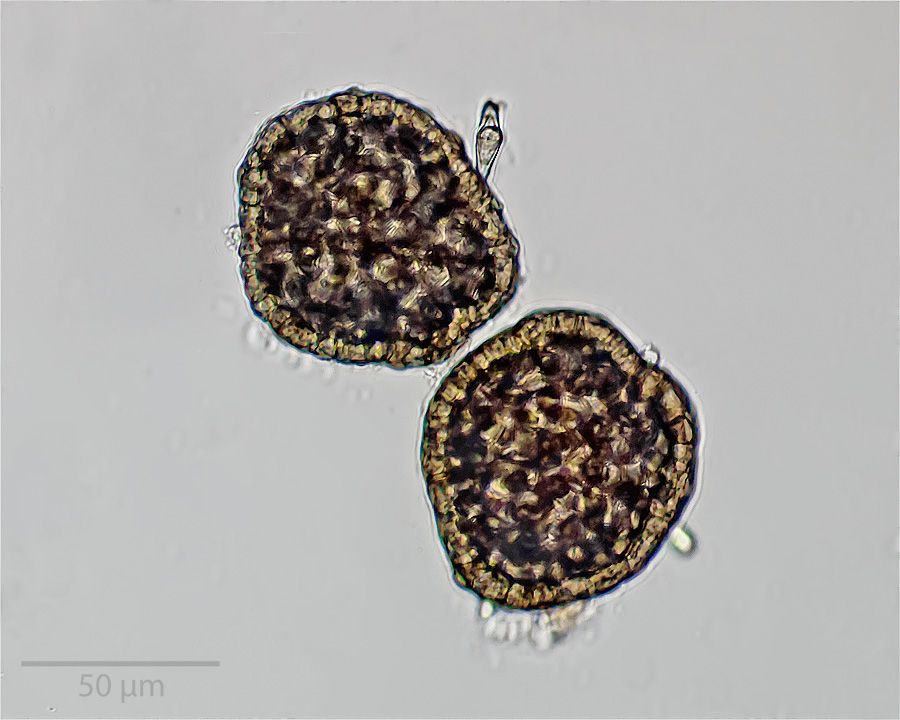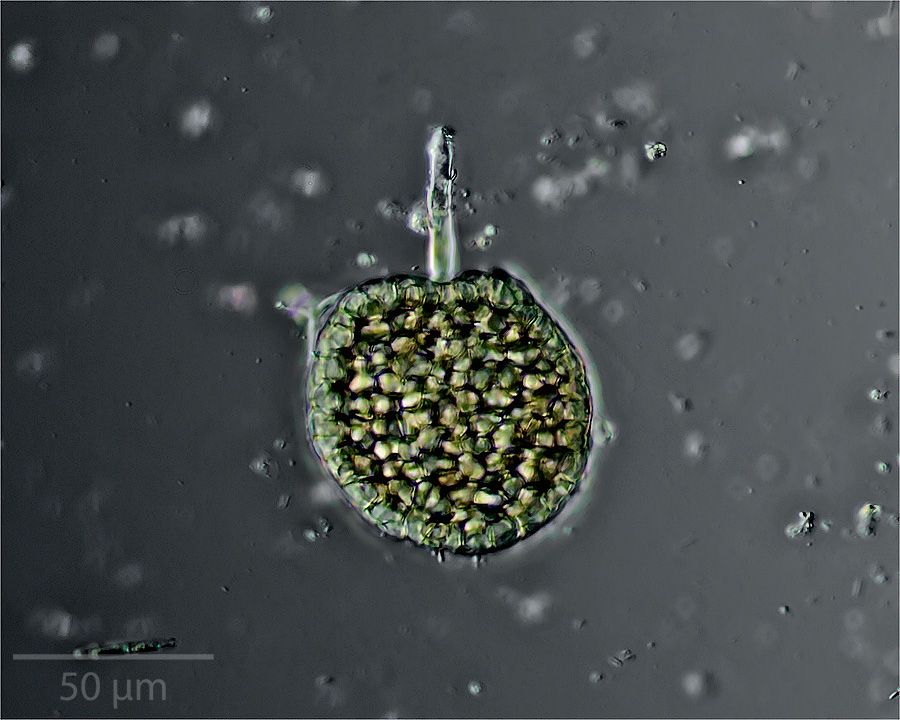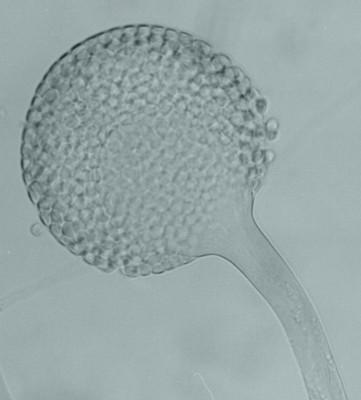Page 1 of 1
Help with identification
Posted: Wed Oct 15, 2014 2:14 pm
by gekko
I found these in water from a pothole in the yard after it had been raining for a while. I don't remember seeing something like that before. Many thanks for suggestions of what they might be. Objective: 20x.
1. Oblique illumination:

2. DIC:

Re: Help with identification
Posted: Wed Oct 15, 2014 3:56 pm
by 75RR
Are those amoeba like tendrils in the first photo, lower of the two. At 4 and 7 o'clock?
Re: Help with identification
Posted: Wed Oct 15, 2014 5:56 pm
by Peter
Hi Geko,
Might it be pollen?
Peter.
Re: Help with identification
Posted: Wed Oct 15, 2014 7:23 pm
by gekko
75RR, thank you for your suggestion. At first blush, I also thought that the protrusions (including the "stems") were pseudopods of amoeba, but, at least for the short duration that I watched them, nothing moved. Also, I took multiple images for a focus stack (not shown) and I saw nothing "inside" that suggests anything but what we see in the images above. I went back and estimated the thickness (or depth) of the objects from the focus stack images, and a rough estimate would be about 10 µm, so they are flat rather than spherical.
Peter, thank you for your suggestion. I guess they could be pollen, but does the fact that they are flat (please see my answer to 75RR above) or that they have "stems" (most of the ones that I saw in the field of view appeared to have stem-like projections) argue against them being pollen? I don't know enough to say one way or the other.
Re: Help with identification
Posted: Thu Oct 16, 2014 11:32 pm
by gekko
While trying to identify a small ciliate that I encountered recently, I accidentally came across what looks to me to be the same unknown object shown above on
Josh's microlife web page under "Microlife: Duck pond - Muddy water" (scroll down, under "Unknown objects"):
http://microlife.parvarium.com/DP1205/
Interestingly, "my" object was also found in muddy water.
Re: Help with identification
Posted: Sat Jan 10, 2015 12:24 pm
by swera
This article is absolutely interesting. I'll do more research from that starting point. Thanks a lot!!
Re: Help with identification
Posted: Sat Jan 10, 2015 7:32 pm
by vasselle
Bonjour Gekko
ça ressemble fort un amibe.
Cordialement seb
Re: Help with identification
Posted: Sun Jan 11, 2015 1:08 am
by gekko
vasselle wrote:Bonjour Gekko
ça ressemble fort un amibe.
Cordialement seb
Thank you, seb, for your suggestion. I don't think it is amoeba for the reasons I mentioned above in my reply to 75RR (what look like "pseudopods" did not move, it was flat with thickness about 10 µm, and focusing through it did not show any structure inside other than what we see in the images).
Re: Help with identification
Posted: Mon Apr 06, 2015 7:16 pm
by Mintaka
gekko wrote:Peter, thank you for your suggestion. I guess they could be pollen, but does the fact that they are flat (please see my answer to 75RR above) or that they have "stems" (most of the ones that I saw in the field of view appeared to have stem-like projections) argue against them being pollen? I don't know enough to say one way or the other.
I think Peter is right and we are looking at a beautiful micrograph of a germinating pollen grain.
http://en.m.wikipedia.org/wiki/Pollen_tube
Also, is it perhaps possible that a highly opaque particle may appear squatter than it really is when inspected according to your method above, i.e. it may leave one with a false impression of flatness?
Re: Help with identification
Posted: Mon Apr 06, 2015 7:49 pm
by gekko
Thank you Mintaka, and thank you Peter. I may be wrong, but I don't think opaqueness would affect the estimate of depth, as it is not so opaque as to prevent one from estimating when the top or bottom surface is in focus. Which is why I questioned whether it could be pollen (but again, I may be wrong in my doubt).
Re: Help with identification
Posted: Mon Apr 06, 2015 11:09 pm
by mrsonchus
Hi Gekko - nice images for sure. I've looked at lots of pollen under the 'scope since I started and I really don't think these are pollen grains... The tube-like structures don't look like pollen-tubes - they look far too rigid in their shape and direction of growth to me. Pollen tubes tend to be pretty gelatinous, meandering and flexible rather than an organised structure that appears to have a degree of rigidity..
Also the grains would be more 'plumped-up' and almost spherical if in contact with water. They also look as though they have a more cellular border than a pollen grain's exine will resemble under a light microscope The look of them is not 'fine' enough, there is no ornamentation visible and no apparent pores or slits from which any pollen tubes would (in the majority of pollens) originate and leave the confines of the grain-proper.
They look plant-like but maybe more akin to a spore perhaps?
Just a few thoughts - I'm probably way off course....
Re: Help with identification
Posted: Mon Apr 06, 2015 11:34 pm
by gekko
Many thanks, John, for your input. I tend to agree with you in that all the pollen that I've seen is spherical or nearly so, and those are quite flat and, therefore, what you say makes sense to me, despite my ignorance. Perhaps they are some kind of spore.
Re: Help with identification
Posted: Tue Apr 07, 2015 3:10 am
by Mintaka
Interesting points John B, and ones that certainly have me now doubting the pollen hypothesis. I must admit that I don't recall having seen pollen under the microscope for myself, and I relied maybe too much on web imagery. The subtleties noted when examining a thing for oneself is of course invaluable in fututre identifications, and this thread has now left me with the urge to go and tap a few inflorescences against a slide and check the result out under the microscope.
Gekko, true, if the opacity was not complete then the "focus through" technique is a useful and valid way of getting a feel for the shape of the object. I was unsure if the highlighted parts of the specimen was due to transmission of light, or due to the use of an oblique illuminant.
In the meantime, it appears that the mystery lingers!

Re: Help with identification
Posted: Tue Apr 07, 2015 4:13 am
by mrsonchus
gekko wrote:Many thanks, John, for your input. I tend to agree with you in that all the pollen that I've seen is spherical or nearly so, and those are quite flat and, therefore, what you say makes sense to me, despite my ignorance. Perhaps they are some kind of spore.
Had a thought, whereas pollen is, as far as I know always, prompted into 'doing something' by the addition of water - 'plumping-up' and often growing a pollen-tube (this can happen very quickly and may be 'watched live'), spores tend to 'do something' when they are
dried/dry - that is their capsule (that which we may be seeing in your pictures) will not only split open from a special area (stomium) of thinner cells, but peel-back as a result of a specialized structure (annulus) that often looks a lot like a 'spine' contracting then 'pinging' the contents of the capsule (the spores themselves) outwards. Try letting a droplet of liquid (water?) containing these objects simply desiccate upon a slide then see if you 'get a reaction'.... Might be very interesting..
Here's a picture - not all annuli are as obvious as this one - some are zonal areas rather than the classic 'backbone' type that is very obvious in this picture..
https://classconnection.s3.amazonaws.co ... 808532.jpg
The center chamber (containing the spores) resembles your picture a little.
It's a possibility that you have perhaps some fern-sporangia here. Considering the apparent lack of a clearly defined annulus, you may of course have something akin to a fungal sporangium, as seen on this superb web-page:
http://website.nbm-mnb.ca/mycologywebpa ... ycota.html and particularly in this picture from that page:

The zygosporangium has the regularity of structure seen in your pictures but with the 'softer' look when compared to the fern sporangium?
It's perhaps a possibility.

Re: Help with identification
Posted: Tue Apr 07, 2015 12:44 pm
by gekko
mrsonchus wrote:gekko wrote:Many thanks, John, for your input. I tend to agree with you in that all the pollen that I've seen is spherical or nearly so, and those are quite flat and, therefore, what you say makes sense to me, despite my ignorance. Perhaps they are some kind of spore.
Had a thought, whereas pollen is, as far as I know always, prompted into 'doing something' by the addition of water - 'plumping-up' and often growing a pollen-tube (this can happen very quickly and may be 'watched live'), spores tend to 'do something' when they are
dried/dry - that is their capsule (that which we may be seeing in your pictures) will not only split open from a special area (stomium) of thinner cells, but peel-back as a result of a specialized structure (annulus) that often looks a lot like a 'spine' contracting then 'pinging' the contents of the capsule (the spores themselves) outwards. Try letting a droplet of liquid (water?) containing these objects simply desiccate upon a slide then see if you 'get a reaction'.... Might be very interesting..
Here's a picture - not all annuli are as obvious as this one - some are zonal areas rather than the classic 'backbone' type that is very obvious in this picture..
https://classconnection.s3.amazonaws.co ... 808532.jpg
The center chamber (containing the spores) resembles your picture a little.
Yes, I would say it resembles my picture perhaps more than a little. That, to my eyes (bad as they are) is the closest thing I've seen. Regarding your suggestion to desiccate them, well I've seen those things only that one time, but if I ever see them again, that would be what I would do and see what happens. Very useful new (to me), interesting, and useful information in your reply. Thank you for taking so much trouble and also sharing so much expertise and information!




